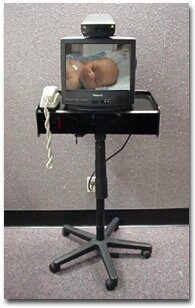Services Description
The first service is for antepartum patients who are confined to a hospital bed for extended periods as a result of complications of their pregnancy. These patients, particularly those who reside in distant rural communities, experience significant isolation from their families as a result of their condition. Lengths of stay for antepartum patients can last from one to several months. Because spouses of expectant mothers have to continue to work at their jobs, and children have to continue to attend school, separation anxiety can be significant for the expectant mother, and for the family members who remain at home. In this situation, family members undoubtedly make regular telephone calls to the hospitalized expectant mother. Seeing Is Believing allows expectant mothers to see and talk to their distant family members using low cost videoconferencing technology operating over a single regular telephone line. The system also allows family members to see the expectant mother. The value in this service is in allowing family members to see each other while they talk to each other, for the same cost as a regular telephone call. The impact of adding a visual component to family communications under these circumstances cannot be overstated or undervalued.
The second service is for use in the Neonatal Intensive Care Unit (NICU). Parents of NICU patients are encouraged to be present in the NICU with their infants as much as possible. However, when the babys family resides in a distant rural community, work and family responsibilities combined with extended lengths of stay make it difficult for parents and family members to be present continuously. In almost every case, separation of family members results. While one parent may be able to stay in Des Moines with the NICU patient, often the other must return home to work and family responsibilities. Separation of one or more parents and siblings from the NICU patient can have several negative impacts on all family members. Separation of the parents creates additional marital stresses during an already trying time and bonding to the infant by one or the other of the parents can be delayed. Additionally, this situation takes one parent out of the household and creates stresses on siblings. Further, inability of siblings to see and spend time with the infant delays their bonding. Low cost easy to operate videoconferencing technology can be used to enhance the level of communication between separated family members, allow distant parents and siblings to monitor the status and wellbeing of the NICU patient, and just see the patient. For separated spouses and siblings the impact of being able to see a distant family member while talking to them, or just see the new family addition regularly, despite geographic separation, cannot be overstated or undervalued.
Return to Top
Technology Utilized
The two-way interactive compressed videoconferencing technology utilized for these services is both relatively new and highly revolutionary. The product used is the ViaTV Phone, manufactured by 8x8, Inc.. (Note: The ViaTV phone remains in use, however, it is no longer manufactured by 8x8 Inc. Other similarly affordable replacement products are now available.) This technology is ideally suited for these services for the following reasons:
- Uses a single regular telephone line to send and receive both audio and video images. Can be used with any existing telephone line already in a patients home. Direct phone line connections do not require the complicated security measures necessary with communications routed through the Internet.
- Incurs no special telecommunications costs. A two-way audio and video call costs the same as a traditional local or long distance audio only call. Users do not have to have and pay for Internet access.
- Very simple to install and operate. Connects to the users regular telephone and TV set. Set up time is five minutes or less. Does not use complicated and expensive computers. A standard touch-tone telephone handset controls all functions. Users need not be computer literate.
- Extremely affordable. Assuming a standard telephone and TV set are already available, the basic product costs approximately $499 to place in a patients home. Patients and relatives may choose to purchase their own systems and use them amongst themselves after the patient is discharged.
The ViaTV Phone does not provide TV quality images. The video pictures are unquestionably softer and slower to refresh than a standard TV image or than the much more expensive and complicated compressed videoconferencing systems used by the MRTC. However, the image and audio quality are satisfactory for many social and medical applications. The ViaTV Phone has been used extensively for telepsychiatry and telehome health services delivery with resounding success. It represents a very practical and affordable way to add significant value (the ability to see the person on the other end) to a conventional telephone conversation while not incurring the usual high costs of more traditional videoconferencing systems.
The ViaTV Phone allows the two parties to establish a regular voice telephone call first. Then upon mutual consent, one party initiates a video call. After approximately 30 seconds a video call is established and the parties continue their conversation while simultaneously seeing the party they are talking to at the other end. At the end of the call, both parties just hang up the telephone to terminate the call.
The ViaTV phone has several features that enhance its value. It allows the user to select settings that maximize picture quality, or fluidity of motion. It has a remote electronic pan, tilt, and zoom feature. And it has an auto-answer feature that allows the calling party to enter a security code at a prompt and automatically establish a video connection without requiring the distant party to answer. After calling the NICU, and being connected to the proper extension, this feature will be used by the parents of a NICU baby to make regular visual status checks on a baby without having to occupy the time of a staff nurse. Of course the parents will want to talk to a nurse periodically as well. But, just being able to call in and see the baby at any time (anytime the baby is not sleeping in a hooded isolette) provides reassurance for the distant parent and contributes to the parents bonding to the child. Making it possible for the child to hear the distant parents voice, even over the telephone, may contribute to the childs bonding to the parent as well.
Return to Top
Policies and Procedures
"Seeing Is Believing" is implemented in the antepartum and neonatal intensive care units on a voluntary basis. Patients and families are advised of its availability and asked if they would like to participate in this service. There will be minimal cost to the patients to use the service during the trial period just the cost of the telephone calls they make to establish a video connection. Patients and NICU baby parents have to sign a consent form and a few specifics regarding the use of the service are conveyed to the patient and/or parents. A loaner unit is then be provided to the family and they receive elementary training on how to install the ViaTV Phone in their home. A roll-about unit is then placed at the patients bedside. Distant family members are then able to call into the patient unit and establish a video call at anytime it is not deemed to be inappropriate by antepartum or NICU staff. The appropriate nursing personnel always have control over whether or not a babys camera is turned on and available to establish a video call. Similarly, both the nurse and the expectant mother have the ability to determine the appropriate time to receive and establish a video call. Other appropriate restrictions on the use of the videophone are identified from time to time.
User satisfaction and utilization statistics are solicited from patients and parents participating using self-reporting tools. Use of the service and the ability to receive a loaner system for installation in the patients/parents home will be contingent upon participation in the evaluation program.
The Midwest Rural Telemedicine Consortium provides technical support for the program. MRTC staff provide training in the installation and use of the technology to the nursing staff as well to the patient/parents at Mercy Medical Center-Des Moines. Should assistance be needed at the patients/parents home, a MRTC staff person is available to assist telephonically. The need for on-site installation services has never occured. MRTC staff are also available to troubleshoot and resolve technical difficulties should they arise while using the technology.
Because the technology used for these services is both affordable and readily available to the consumer users other than the immediate family members of the patient may want to utilize these services. Responsibility for distribution of the telephone number and security code for the individual system at Mercy Medical Center-Des Moines will rest with the patient, or parent(s) of the NICU baby. Anyone to whom they distribute the number and code will be authorized by them to use the service. This is explained in the consent form.
Return to Top
Summary
These two initiatives are primarily intended to add social value to the high quality services Mercy Medical Center-Des Moines already delivers to its patients in the Womens and Childrens Health Services department. Patients and parents impressions on the value and success of these initiatives has been universally high. These services represent psychosocial considerations for, and support of the patients for whom we care. The cost to provide these services is considered negligible compared to the positive impact they have on our patients.
|



